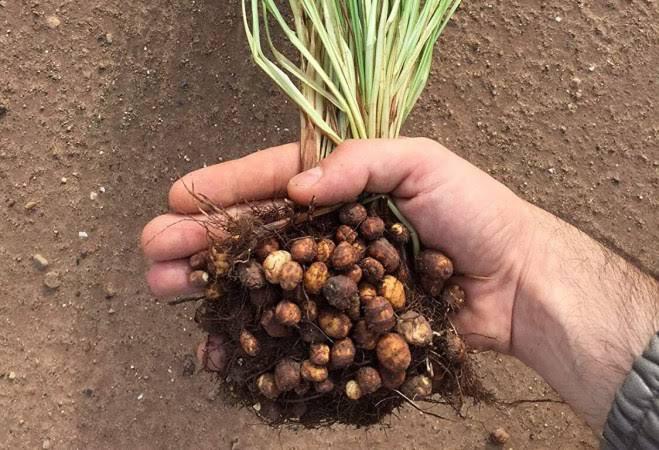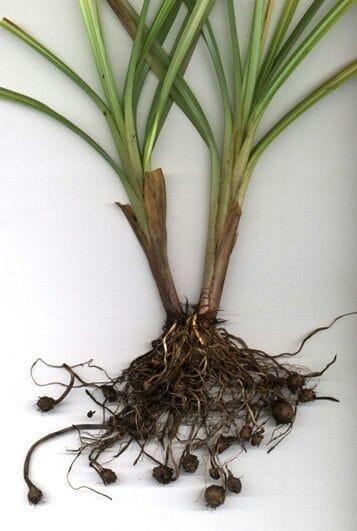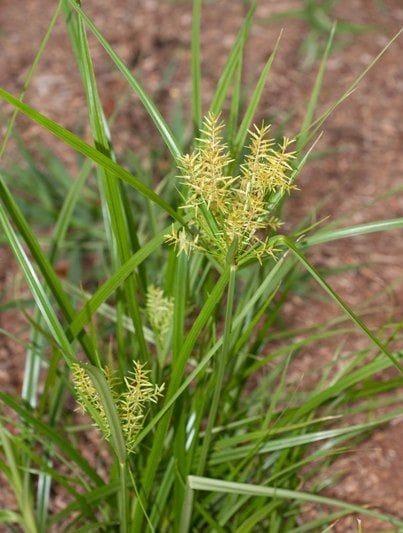Tiger Nut Plant
Tiger nut, a perennial, grows in well-drained sandy-loam soil and full sun. It tolerates moist to wet conditions and benefits from consistent moisture.
Habit
Perennial
Height
0.5 to 1.0 m
Growth
Fast
Soil
Well-drained, Sandy Loam
Shade
Full Sun
Moisture
Moist to wet
Edible
Yes
Medicinal
Yes
Origin
Africa, Asia
Climatic Condition
Arid, Semi-arid
Temperature (°)
20°C to 30°C
Humidity (%)
50% to 60%
Potting media
50% Loam, 40% Sand, 10% Organic Matter
Fertilizers
Organic Fertilizer
Watering
Minimal watering
Plant Weight
1 to 2 kg
Flowering Time
Summer to Fall
Soil Ph level
6.0 to 7.0
Water Ph level
6.0 to 7.0
Soil EC
0.4 to 0.6 mS/cm
Yield Per Plant
2 to 3 kg per plant
NPK ratio
10:10:10
life Span
2 to 5 years
Health Benefits
High in Nutrients, Medicinal
Suggested Grow Media or Potting Mix ?
40% compost, 30% peat moss, 30% perlite
Suggested Fertigation/Fertilizers
Fertilize every 4 weeks with a balanced, water-soluble fertilizer.
Common Diseases and Remedies
Root rot.
Stunted or poor growth, Pale leaves, Wilted, yellowed or brown colour leaf.
Wash the plant roots under running water to clean the soil off, Prune back the foliage of your plant.
HEALTH BENEFITS
1. Rich in fiber and nutrients: Tiger nuts are rich in fiber, vitamins, and minerals, making them a nutritious snack.
2. May help lower cholesterol: The fiber and antioxidants in tiger nuts may help lower cholesterol levels and improve heart health.
3. May help regulate blood sugar: Tiger nuts' fiber and antioxidants may also help regulate blood sugar levels.
What are tiger nuts?
The tiger nut plant, scientifically known as Cyperus esculentus, is a perennial grass-like plant that produces edible tubers commonly known as tiger nuts or chufa. These tubers are small, shriveled, and have a sweet, nutty flavor. The plant has elongated triangular stems with grass-like leaves and grows up to 1 meter in height. Small yellow-brown flowers bloom in umbrella-like clusters at the top of the stems.
What types of tiger nut plants are there?
There are many different types of tiger nut plants, each with its own characteristics. The most common varieties are:
1. Black Tiger:
This variety has a dark, almost black rind and is known for its sweet taste.
2. Valencia:
Valencia tiger nuts are large and slightly chewy. It is often used to make horchata, a popular drink in Spain.
3. Chufa:
Chufa tiger nuts are smaller and sweeter than other varieties. Often used in baking and cooking.
4. Premium:
Premium tiger nuts are larger and more uniform in size. It is often used as a snack or sweet.
5. White:
White tiger nuts have a creamy white color and a mild sweet taste. Often used in desserts and baking.
How do you care for tiger nuts?
Location
Tigernut plants grow in temperate climates and are usually grown in areas with long, hot summers. Prefers well-drained sandy or loamy soil and is drought tolerant.
Tiger nuts are grown in different parts of the world, including:
1. Mediterranean
2. Africa
3. Europe
4. America
In the United States, tiger nuts are grown primarily in southern states such as Florida and Florida. Texas has a climate suitable for cultivation.
Sunlight
Tigernut plants require full sun to grow. They need at least 6 to 8 hours of direct sunlight per day to grow properly and form tubers. In areas with hot summers, partial shade during the hottest parts of the day can be beneficial to avoid stressing the plant. However, in most cases, tiger almonds should be planted where they receive full sunlight throughout the day.
Soil
Tigernut plants prefer well-drained, sandy or loamy soils. It tolerates a variety of soil types, including poor sandy and slightly acidic soils. However, it grows best in well-drained soil that is rich in organic matter.It is important to avoid waterlogged or clayey soils as the tubers may rot. Adding compost or well-rotted manure to the soil before planting improves soil fertility and drainage, resulting in healthier plants and higher yields.
Hydration
Tigernut plants require regular watering, especially during the growing season. It is important to keep the soil evenly moist but not soggy. Excessive watering can lead to tuber rot and other plant diseases.
Nourishment
Tigernut plants benefit from regular feeding with a balanced fertilizer that supports growth and tuber development. During the growing season, a 10-10-10 or similar ratio fertilizer can be applied every 4 to 6 weeks.
Issues
Tigernut plants are generally hardy, but may be susceptible to some common problems:
1. *Pests:* Several pests such as: : B. Nematodes can be a problem for tigernut plants. These microscopic insects can attack roots and tubers, causing stunted growth and reduced yields. Controlling nematodes can be difficult, but using nematode-resistant varieties and maintaining crop rotation can help.
2. *Diseases:* Tigernut plants can be affected by various fungal and bacterial diseases such as root rot, spot rot, and tuber rot. Good hygiene practices, such as removing infected plant material and using disease-resistant varieties, can help prevent these problems.
Frequently asked questions about growing tigernut plants?
How do you care for your tiger nut plant?
To care for your tiger nut plant and ensure its healthy growth, consider the following tips.
1. *Water:* Water the tiger nut plant regularly, especially during dry periods, to keep the soil evenly moist but not waterlogged.
2. *Fertilization:* Apply a balanced fertilizer every 4 to 6 weeks during the growing season to support plant growth and tuber development.
3. *Weeding:* Remove weeds regularly to reduce competition for nutrients and water.
4. *Mulching:* Applying a layer of mulch around plants to retain soil moisture and suppress weeds.
What is the tiger nut plant used for?
The tiger nut plant has several uses, including:
1. *Food:* Tiger nuts are edible and can be eaten raw, roasted, or cooked. It is often used in cooking, drinks (such as horchata), and snacks.
2. *Flour:* Tigernuts can be ground into a gluten-free flour that can be used as a wheat flour substitute in baking and cooking.
3. *Oil:* Tiger nuts can be processed into oil and used in cooking and as a source of unsaturated fat.
4. *Animal Feed:* Tiger nuts are rich in nutrients and energy and can be used as livestock feed.
5. *Cosmetics:* Tigernut oil is used in cosmetics and skin care products due to its moisturizing and antioxidant properties.
Can I grow tiger nuts indoors?
Tiger nut plants grow best outdoors as they require full sun and a warm, well-drained environment to thrive. However, given the right conditions, it is possible to grow tiger nuts indoors in large containers or pots.
Which pot is best for growing a tiger almond plant?
If you want to grow tiger almonds in pots, it is best to choose a large container with a minimum diameter of 12 to 18 inches and a depth of at least 12 inches. This will give the plant enough space to grow and the tubers to develop.

